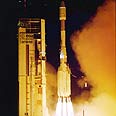
Israel launches satellite (Archive photo)
צילום: אריה אגוזי התעשייה האוורית
Fig leaf in the sky
Publicity surrounding Eros B launch meant to cover up intelligence failures
Not even the best copywriter could have come up with a better fig leaf to cover up Israel's intelligence community's nakedness than the name "Eros."
The Israeli public has been subjected in recent days to an incredible public relations campaign surrounding the launch of the Eros B satellite. We were told the launch was "Israel's response to Iran's nuclear program."
But in light of all the news reports about the satellite, one obvious question remains: If this really was Israel's response, how could it be that all the relevant details are on the public record? And with the IDF censor's blessing to boot?
Arrogant move
The reason is that the move is one of arrogance, exaggerated in its very nature. The Eros B is a commercial photography satellite manufactured by the Israel Aircraft Industries and launched by ImageSet. The fact that the satellite was launched was laudable, but has nothing to do with Israel's intelligence capabilities.
First of all, it is a commercial satellite in every way. Any one can go out and buy the photographs it produces from the company operating the satellite. There are at least four more like it circling above our heads, put there by European and American companies. And at least one, called Digital Globe, takes even better pictures than the Eros.
Yedioth Ahronoth was the first media outlet to publish that hired Digital Globe to photograph the uranium enrichment facility at Isfahan two years ago. And other photographs, taken by the same company and published last week, are at least as good as Israel's "spy satellite."
Lack of photos
Secondly, the Israeli security establishment, which has suffered a lack of photographs since the failed launch of the (real) spy satellite "Ofek 6," has openly spent a lot of money to obtain the relevant images. The only thing that has changed is that now the money will go to an Israeli company rather than a foreign one.
Third, American spy satellites are much better than the Eros, and Israel enjoys reasonably free access to the images they provide.
Fourth, The Iranians, believe it or not, also read newspapers. They've also heard of satellites, and they are making every effort to hide what they don't want the cameras to see. Cameras are important, but they cannot replace other information-gathering techniques, such as living, breathing spies and wire taps.
Not from satellites
It's a fact: All our information about Iran's nuclear program (as well as Iraq's and Libya's before) came from other intelligence sources, not from satellites.
And here lies the great secret, the one everyone is trying to hide: Israel's intelligence community (like those in the United States and Western Europe) has failed heretofore, with several pointed exceptions to do away with the danger it itself calls the greatest threat facing the country.
It’s a double failure, really. Israel not only failed to prevent Iran from going nuclear, but also failed to know enough about what was going on inside Iran.
One example is the too-late revelation of the real way in which Iran decided to build its bomb – by enriching uranium through the use of centrifuges, aided by Pakistan. It was not as Israel expected - by using the Russian-built Busheir reactor. The main address for this failure is the Mossad, but the blame should not end there.
This is the twisted truth. Not even stellar PR or banner headlines can cover it totally up.










